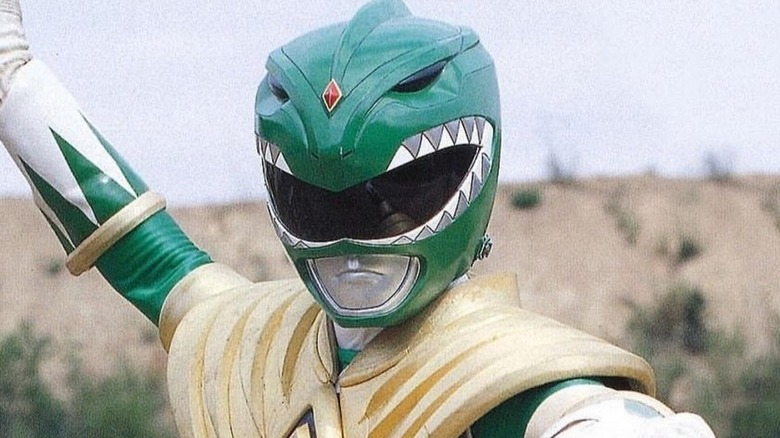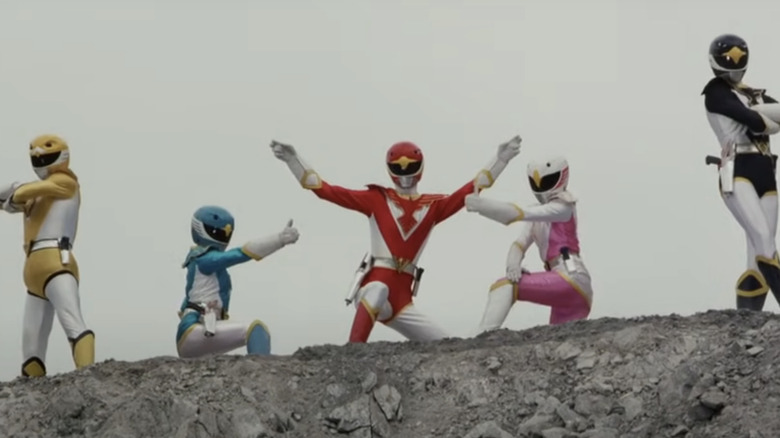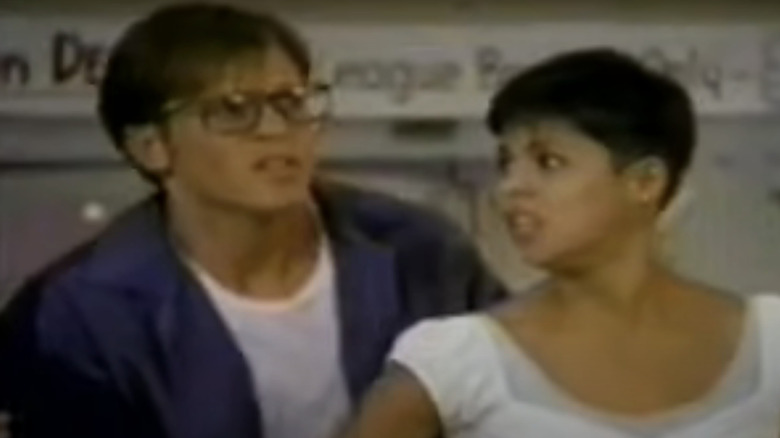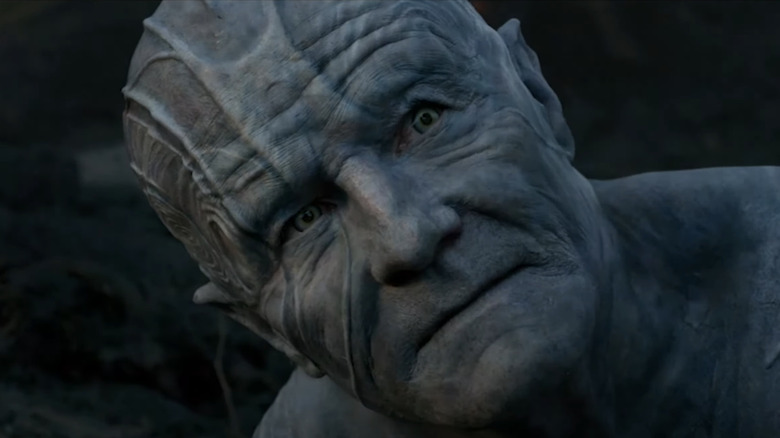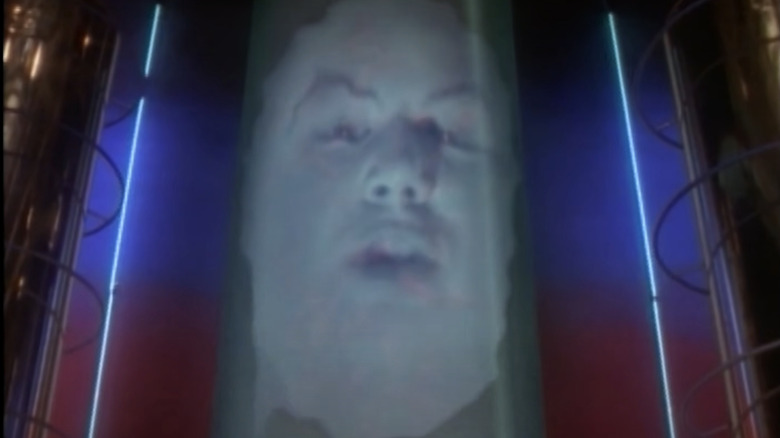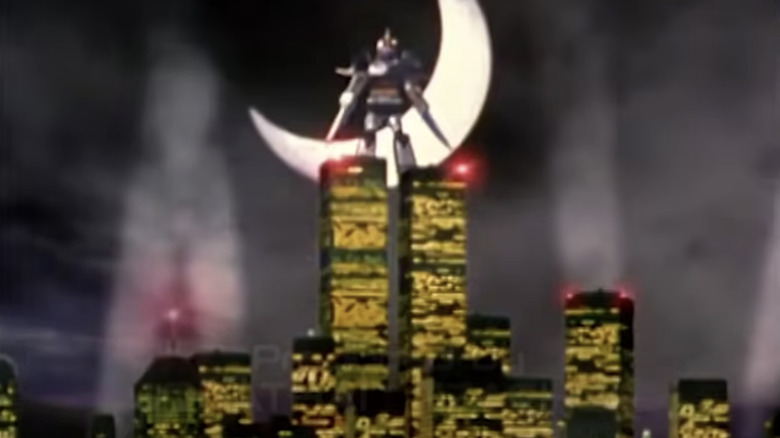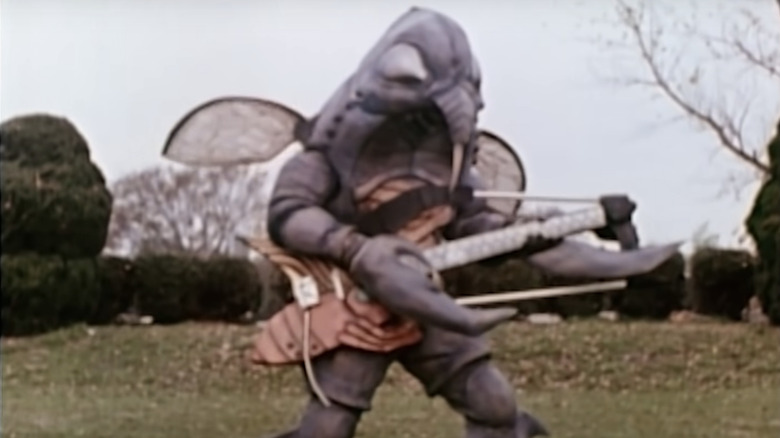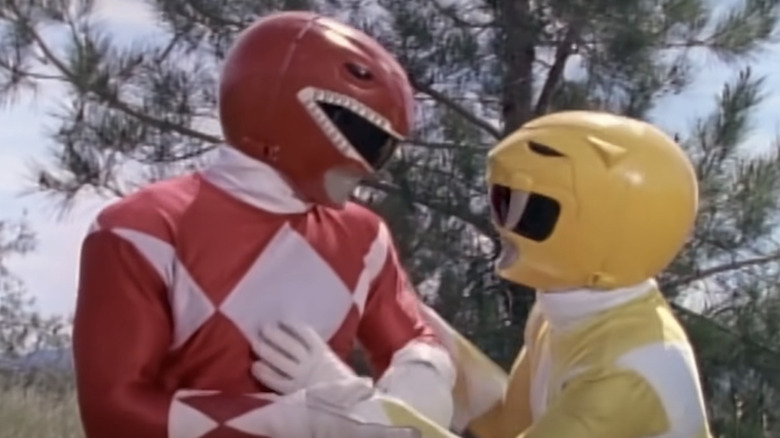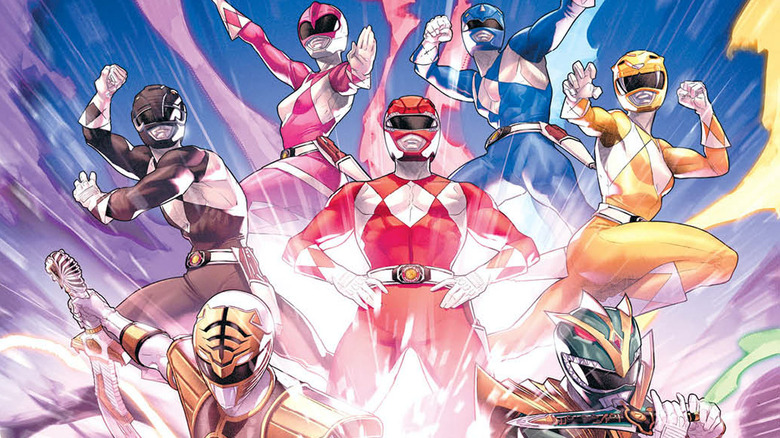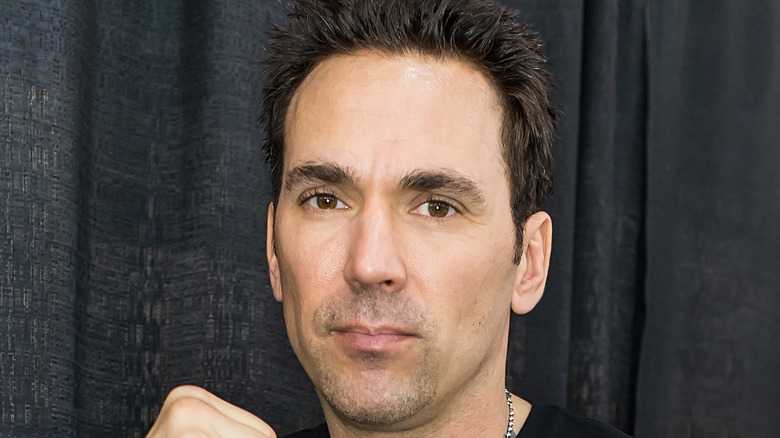Mighty Morphin Power Rangers Details Only True Sentai Warriors Know
It's been decades since the legendary Saban Entertainment introduced the world to the heroes of "Mighty Morphin Power Rangers," a gaggle of campy, colorful, kick-butt, karate-happy teens with a seemingly endless supply of giant mechs and maniacal villains. In that time, the franchise and its many, many iterations have gone on a wild Megazord's ride of ups and downs, from creating one of history's biggest toy sensations to spawning one of its most notoriously mistreated casts. With so much time, so many different incarnations, and so much notoriety to its name, it's no surprise that the "Power Rangers" dynasty is chock-full of interesting and little-known facts and secrets.
The cast is an interesting enough subject unto itself. When you add in the franchise's odd corporate history, extended media empire, and absolutely bonkers canon, there are enough fun "Power Rangers" details to extend to Rita Repulsa's moon base and back. Some, like the alleged "Power Rangers" curse, are dark, while others, like the seemingly endless amount of dedication exhibited by the late Jason David Frank, are light. Much of it is just crazy. Like the Zordons of knowledge, we've assembled the most fascinating franchise facts to battle the monsters of ignorance. These are the "Mighty Morphin Power Rangers" details only true Sentai warriors know.
A recycled show
It's common knowledge that the original "Mighty Morphin Power Rangers" was heavily inspired by a similar series already airing in Japan. But what you may not know is that the original, Japanese series, known as "Super Sentai," actually provides half the footage for the American "Power Rangers," and has the entire time.
When you tune into an episode of "Power Rangers," whether it's Season 1 of "Mighty Morphin Power Rangers" or the latest season of "Power Rangers Dino Fury," you're really watching two shows spliced together. As The Los Angeles Times reported all the way back in 1993, all the scenes in which the Rangers have their helmets on — meaning all the karate fights, all the morphing sequences, and all the Zord action — are made of footage taken straight from the corresponding season of "Super Sentai." Then, when it's time for the Rangers to take the outfits off — meaning all scenes set in day-to-day life and any time a Ranger talks without voiceover — new scenes filmed for the show featuring the American actors are used.
In one wild twist of fate, the first seasons of "Mighty Morphin Power Rangers" were so immensely popular that new footage (which diehard fans refer to as the Zyu 1.5 and Zyu 2 footage, after the name of the Japanese series, "Kyōryū Sentai Zyuranger") was shot by the Japanese crew on-demand for the express purpose of being used by the American team to produce more American episodes.
One bizarre pilot episode
One of the most endearing qualities of the "Mighty Morphin Power Rangers" series, especially in its first few seasons, is its low-budget nature. This turns what could be a too-serious teen drama into a delightfully wacky and totally campy action romp. Such goofiness helped the series battle controversies regarding its glorification of violence, and continues to aid adults when they want to turn their brains off and enjoy the brightly-colored series alongside their children. In fact, as outlets like Vox have pointed out, a lack of campiness is one of the major reasons why the 2017 "Power Rangers" reboot failed to wow audiences. As you might expect, Season 1's pilot episode is as zany as it gets (and TV pilots are notoriously bizarre to begin with). But what is certain to surprise you is the fact that a second, even zanier pilot, exists.
Though it was rewritten and reshot (and even recast, in the case of original Yellow Ranger actress Audri DuBois), the first pilot made for "Mighty Morphin Power Rangers" was eventually released during the 1999 special "The Lost Episode." That means that all of its nonsensical glory is available to view online, and boy, it is worth watching whether you're a diehard Ranger fan or not. In addition to featuring a different actress as the Yellow Ranger, the unused pilot also changes the teens' hangout to a blandly white bowling alley, in addition to changing a startling amount of characters' names. Just ask the Rangers' floating head mentor, Zoltar.
Featuring Bryan Cranston
There may not be any 21st century rise to superstardom more unexpected — and, in hindsight, more obvious — than the one Bryan Cranston has enjoyed. Cranston went from being the goofily offbeat dad on "Malcolm in the Middle" to the captivating lead of "Breaking Bad," becoming an Emmy sponge along the way. Believe it or not, "Power Rangers" has been part of that amazing journey, dating back to Season 1 of "Mighty Morphin Power Rangers" and reaching all the way up to the 2017 reboot film.
In 1993, when Season 1 was airing and "Power Rangers" fever was hitting new heights, Cranston — still years away from his breakout roles — found work voicing bit characters on the spandex-happy show. Though most of his roles were extremely minor, he did receive credit for voicing two major villains: Snizzard from the episode "Foul Play in the Sky" and Twin Man from "A Bad Reflection on You." The strained, hitching rasp he uses for both characters is reminiscent of the great kids-show villains of the age — Cobra Commander from "G.I. Joe" comes particularly quickly to mind. These performances prove that even then, Cranston was giving every role his all. This dedication did not go unnoticed: Many years later, when it came time to cast the 2017 "Power Rangers" movie, producers chose Cranston to play the face and voice of Zordon. It's a fitting homage to his early voice work.
The cheapest show on Earth
It's easy to assume that a show made up of footage that's at least half recycled is cheap to make. But the reality of this frugality goes deeper than you could possibly imagine. In truth, "Powers Rangers" is so exceptionally cheap to make, and has, at times, been so successful, that it might just be one of the single most cost-effective series in television history.
One major way in which producers cut costs on "Powers Rangers" is by recycling costumes and props. This practice is a common one across all sorts of TV productions, but the many "Power Rangers" series take it to a whole new level. Consider the list of recycled props used in live-action TV maintained by the media-savvy users of TV Tropes. This list has more entries for "Power Rangers" than any other series, from the Rangers' signatures suits to their colorful weapons to entire monster outfits. "Power Rangers" even managed to repurpose the armor from "Starship Troopers."
The frugality of Saban has a dark side, however, and it mainly involves the treatment of actors. The original "Power Rangers" cast has opened up repeatedly over the years about how poorly they were paid and how pitiful their royalties were, despite the pop culture explosion they helped create. As original Black Ranger actor Walter Jones told Huffpost, "We weren't paid a lot, at all. I could have worked the window at McDonalds and probably made the same money the first season ... [Haim Saban] just had absolutely zero conscience about making billions using our faces because it was his idea and he owned it."
An unfortunate intro sequence
From February 3, 2001 to November 17, 2001, Season 9 of "Power Rangers," "Power Rangers Time Force," hit the airwaves. True to its name, the season is based around time travel, and its intro sequence shows this off. In addition to the usual montages featuring the new team lineup, their colorful suits, and their new Zords, this intro features the Rangers traveling through time. They fly through the age of the dinosaurs, ancient Egypt, the first Moon landing, and more. Just before the end, their Megazord stands triumphantly back in 2001, atop New York City's World Trade Center.
That combination of location and year immediately telegraphs the issues this intro eventually faced. The first sequence involving the Twin Towers was used in every episode up until the 9/11 terrorist attacks. Immediately following this tragedy, the intro was recut in time for the episode that aired on 9/15. It's a credit to the production staff that they were able to respond to such an unparalleled event so quickly, cutting together a second intro sequence with a standard "Megazord posing in the desert" image. Fortunately, all Megazord fight scenes across the many "Power Rangers" seasons are filmed in a studio using miniatures (and, not to mention, in Japan), so no further re-editing was necessary.
A theme song for the ages
There's no one detail about the legendary "Mighty Morphin Power Rangers" theme song, "Go Go Power Rangers," that is worthy of delving into — there are millions. From concept to execution to its eventual position as an iconic piece of '90s culture, "Go Go Power Rangers" is a rock-and-roll-ercoaster of wild details.
The theme song was composed by Ron Wasserman, who opened up to Complex about his incredible process. Based solely on a rough cut of the intro video, his knowledge that the show was called (as he misheard it) "Mighty Morphine Power Rangers," and a prompt from Saban to use the word "go," Wasserman created the song in just two and a half hours. As crazy a story as that is, the song's background and future are just as wild.
Before he hired Wasserman to write the song, Haim Saban worked as a professional songwriter. He helped compose such classics as the themes to "Inspector Gadget" (a song just as "go" heavy as the one that precedes "Power Rangers"),"He-Man and the Masters of the Universe," and "She-Ra: Princess of Power." Once "Go Go Power Rangers" premiered, its popularity led to it being released as a single, which rose all the way to the third-highest spot on the 1994 UK Singles Chart.
A troubled production
Whether it's due to the way Saban treats its casts, the general rigors of life as a young Hollywood actor, or random chance, those who have suited up to play Power Rangers seem to suffer an unusual amount of tragedy. For a show whose main cast is almost always made up of physically fit actors in the prime of life, a surprising amount of the series' stars have passed away at young ages. Perhaps the most famous losses in the "Power Rangers" family are Thuy Trang, the actress who played Yellow Ranger Trini Kwan, and Jason David Frank, who played a number of Rangers over the years. The former died in a car crash at the age of 27, while the latter died by suicide at age 49. Another notable death is Pua Magasiva, a former Red Ranger who died by suicide after he was convicted of assaulting his wife.
Many other unfortunate events have dogged "Power Rangers" actors over the years. Even those that haven't resulted in death seem too numerous and regrettable to belong to just one show. There's the time a fan snuck into 2017's Phoenix Comic-Con and attempted to kill Jason David Frank. There's the case of former Red Ranger Ricardo Medina Jr., who was convicted of voluntary manslaughter for killing his roommate with a sword. These, along with many other unfortunate events, have led to the notion that "Power Rangers" is actually cursed.
If you or anyone you know is having suicidal thoughts, please call the National Suicide Prevention Lifeline by dialing 988 or by calling 1-800-273-TALK (8255).
The wildest spin-offs and rip-offs
You can always count on the free market to follow up a smash hit like "Mighty Morphin Power Rangers" with a stream of spin-offs, homages, and blatant copies. Although many of these lookalike productions have come from competing companies looking to hitch a ride on successful coattails, many of them also come from the original studio, who eternally hope to bottle up another bolt of lightning. Whatever the source, the immediate and explosive success of the "Power Rangers" franchise led to a series of truly wild rip-offs.
From Saban, who understandably didn't want to let their good brand name go to waste, came "Big Bad Beetleborgs" and "V.R. Troopers," along with lesser-known projects like "Masked Rider" and "Los Luchadores" (both of which are worth tracking down online, if only for the nostalgia and/or uncontrollable laughter). Non-Saban companies kept up the pace: Among their biggest and best attempts to cash in on "Power Rangers" mania are "Tattooed Teenage Alien Fighters from Beverly Hills" and "Mystic Knights of Tir Na Nog." Though these series have become little more than pop culture curiosities, no one can deny their chutzpah — or their seriously fabulous names. When's the last time the viewing public was treated to a show as whimsically named as "Tattooed Teenage Alien Fighters from Beverly Hills"?
Power Rangers on the page
Whether you're a millennial purist who only loves the original "Mighty Morphin Power Rangers" seasons, a newcomer watching "Power Rangers Dino Fury," or a lifelong fan who's lived through every event of the complicated "Power Rangers" timeline, we've got good news: The best incarnation of "Power Rangers" exists right now, and it brings every beloved aspect of the franchise together in one package. That incarnation is the current line of comics from BOOM! Studios, and it's worth the attention of fans of all stripes (and diamonds, and dinosaur patterns, and ninja suits).
Like the current "Teenage Mutant Ninja Turtles" series published by IDW, which we've already asserted to be the best incarnation of the TMNT yet, the current "Mighty Morphin Power Rangers" series and its companion projects are the peak of the franchise. The core series has run since 2016, passing the 100 issue mark in September 2022. In that time, it has told some of the most unrestrained, action-packed Ranger stories ever. These comics incorporate multiple teams of Rangers, mostly placing them in original stories, but occasionally taking the opportunity to retell and flesh out preexisting tales. It's thrilling, complex, and just plain cool.
Thanks to solid writing, excellent art, and freedom from production costs, the "Power Rangers" comics have been a relative hit since launch, with good reviews and sales numbers pouring in. If you're a "Power Rangers" fan who's still on the fence about the current comics, let us share one final fact with you: The comics have seen the team crossover with the Justice League, the Ninja Turtles, and even Godzilla.
Jason David Frank, the ultimate Ranger
You might know that Jason David Frank was an important member of the "Power Rangers" canon and community, but you probably don't know the true extent of his influence. A scroll through his filmography will hint at his importance: Frank was featured in a whopping 257 episodes of the series, which is more "Power Rangers" appearances than anyone else in the franchise's history. Yet even Frank's unrivaled on-screen presence doesn't do justice to how integral he was to the series and its community.
For one thing, Frank walked the walk. Not only did he play a martial arts master on TV, he became one in real life, running his own karate academy and even breaking a martial arts world record (as if he couldn't get any cooler, the record was for most pine boards broken while skydiving). Frank was also an eighth-degree black belt with a number of major awards to his name, making his every punch, kick, and flip on "Power Rangers" that much more awesome.
Above all, Frank was the all-time ultimate Power Ranger because of his loyalty to the fan community, which endured long after his tenure on the show ended. Just months before his passing, Frank attended the 2022 Power Morphicon, meeting with fans, signing memorabilia, and leading the whole venue in a rousing chant of "Morphin' time!" Making the appearance even more heartwarming is the fact that Frank had decided years earlier to move past the Rangers to a new pet project, "Legend Of The White Dragon" — yet he still stuck by his original fans.
